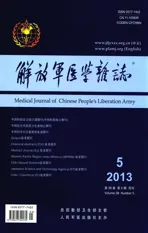腹腔镜下尾状叶肝细胞癌一次性完全射频消融的可行性及安全性评价
2013-03-02姜凯苏明刘洋赵向前张文智王敬董家鸿黄志强
姜凯,苏明,刘洋,赵向前,张文智,王敬,董家鸿,黄志强
射频消融(radiofrequency ablation,RFA)是广泛应用于因肝储备功能差,不能进行手术切除的肝细胞癌(hepatocellular carcinoma,HCC)治疗的有效微创手段。然而,当肿瘤靠近较大(>3mm)的血管时[1],在射频消融过程中,血流的热沉降效应(heat-sink effect,HSE)会导致热量大量流失,使毗邻大血管壁的肿瘤组织残存,需要联合多次酒精注射以消除残存肿瘤组织[2]。对于不能手术切除的尾状叶HCC,其后方与粗大的下腔静脉(IVC)密切相邻,与其他肝段肿瘤相比射频消融过程中产生的热沉降效应更为明显。在CT与B超引导下施行经皮穿刺尾状叶肿瘤射频消融治疗,存在穿刺路径的困难与安全隐患[3-5],而且6个月内的局部复发率高达38.9%[6]。目前有关腹腔镜辅助下尾状叶肿瘤射频消融治疗的报道甚少,且短期(6个月)内容易局部复发[7]。我们采用以局部快速持续高温对抗热沉降效应所导致的热流失,以热传导效应(heat conduction effect,HCE)对IVC壁肿瘤及其周围肝组织进行毁损的方法,对连续10例尾状叶HCC进行了成功治疗,并对腹腔镜下尾状叶HCC一次性完全消融的可行性与安全性进行评价。
1 资料与方法
1.1 一般资料 2009年12月-2010年12月,解放军总医院肝胆外科连续收治10例尾状叶HCC患者,男9例,女1例,平均年龄48(32~65)岁,均合并乙型肝炎后肝硬化,其中中度3例,重度7例;Child-Pugh A级9例,B级1例;肿瘤位于尾状叶腔静脉前段(paracaval portion,PP)4例,Spiegel叶(Spiegel lobe,SL)6例[8],平均直径2.6(1.8~3.2)cm。根据European Association for Study of the Liver(EASL)[9]标准,确诊为HCC。均采用腹腔镜下肿瘤射频消融治疗,术后给予常规保肝治疗,低分子右旋糖酐500m l静脉滴注,1次/d,连续3d。
1.2 射频消融过程 ①采用仰卧位,实施全身麻醉,使用鼻咽部测温计测量体温变化,射频消融设备为Cool-tipTMRF ablation system(Valleylab,USA),以冷却注射用水使RF电极尖端温度保持20℃以下;②于脐部下缘与正中线中部分别切口,置入10mm Trocar,分别放置腹腔镜与腔镜超声探头;左右侧锁骨中线处分别置入5mm Trocar,放置举肝、电凝或吸引器械;③电凝切开小网膜囊与肝胃韧带,充分暴露尾状叶的PP与SL部分,以及下缘IVC前壁,隔离肝十二指肠韧带与周围组织以防止热损伤(图1A、B);④根据术前肝脏增强CT确定电极置入的方向与深度;于剑突下5~10cm处将单电极(3.0cm×2.5cm active-tip cooled,Valleylab,USA)准确置于肿瘤内部,术中超声确认,避免电极头端穿入IVC内;预热后以集束RF电极(2.5cm activetip cooled,3 clusters)加强局部功率,提高温度;⑤RF功率输送范围80~90W,持续6m in后,提高至设备最大功率200W,采用能量反馈系统使功率波动在162~176W(平均165W),持续至16~18m in时,能量输出自峰值突然下降至136~142W,再持续18~20min(总体时间36m in);⑥始终以右侧Trocar进入的吸引器或其他辅助器械(图2A、B)对肿瘤及其周围组织适当加压,特别是从尾状叶下缘与IVC交界处头端加压(以不致肿瘤破裂为限),同时观察IVC前壁的颜色变化;⑦当肿瘤组织变为深黄色或浅褐色,周围肝组织变为浅黑色或深褐色,以及IVC前壁变为浅褐色时(图2C),停止消融与冷循环,测定RF电极尖部温度与鼻温,在停止消融6min后拔除电极;⑧再次检查消融区域周围组织与脏器无损伤,针道无出血,以生理盐水冲洗消融区域降温。

图1 腹腔镜暴露尾状叶Fig.1 Laparoscopic view of caudate lobeA. Front wall of lesser omentum, through which the caudate lobe (white solid arrow) could be seen just at right of ligamentum hepatoduodenale (white hollow arrow); B. Aft er incision of front wall of lesser omentum, the PP and SL part with tumor (T) of caudate lobe were seen having a gap with lesser gastric curvature (white solid arrow), and ligamentum hepatoduodenale could be separated (white hollow arrow)

图2 射频消融过程尾状叶与IVC形态变化Fig.2 Morphological changes of caudate and IVC during radiofrequency radiation (RFA)A. Explore and isolate the caudate tumor (T) and ligamentum hepatoduodenale (white hollow arrow), lesser gastric curvature (G) with dissecting forceps (white solid arrow); B. The tumor (T) after RFA turned into dark brown, with continuing ablation of normal liver (white solid arrow), the front wall of IVC turned into white (white hollow arrow); C. After RFA, the caudate turned into dark brown (white solid arrow) and front wall of IVC turned into light brown (white hollow arrow)
2 结 果
10例患者均顺利实施腹腔镜消融治疗。术中平均出血量16.5(10~30)m l,平均手术时间110(90~150)m in。消融结束时,消融区域平均温度86.4(83~97)℃,鼻温平均升高1.5(1.1~1.8)℃。术中7例出汗量大,补充生理盐水,但血压与脉搏无显著变化。术后分别于1、3、5、7d复查肝功能,除第1天丙氨酸转氨酶(ALT,118~179U/L,平均143U/L)、天冬氨酸转氨酶(AST,124~192U/L,平均158U/L)升高明显,合并重度肝硬化的6例患者白蛋白(ALB)稍降低外[下降1.5~2.7g/L,平均下降1.8g/L),其余时间点各指标均无明显变化,经保肝治疗7d后基本恢复至术前水平。术后3d复查CT,低密度区完全覆盖肿瘤和大部分尾状叶组织。2例术后出现短暂右侧少量胸水,1例(Child B级)出现短暂少量腹水;无血红蛋白尿及IVC血栓、出血、肾衰等并发症。所有患者肿瘤消融术后无任何其他补充治疗,术后至少6个月复查均无局部复发征象,达到一次性完全消融(图3、4)。随访24~36个月,所有患者生存良好。

图3 一例52岁男性患者消融前后肝脏增强CT表现Fig.3 Contrast-enhanced CT of a 52-year-old male patientA. The tumor (white solid arrow, 2.5cm×2.3cm) was located in SL and PP part of caudate lobe (white circle), and attached ontofront wall of IVC (white hollow arrow); B. 36 months after RFA, showing a shrunk ablated region with nofocal recurrence (white solid arrow), and no thrombus form ing in IVC (white hollow arrow), and another ablated region of new lesion in Sg.Ⅶ 27 months after RFA (black arrow)

图4 一例49岁男性患者消融前后肝脏增强CT表现Fig.4 Contrast-enhanced CT of a 46-year-old male patientA. The tumor (white solid arrow, 2.7cm×2.8cm) was located in caudate lobe and adjacent tofront wall of IVC (white hollow arrow);B. Contrast-enhanced CT 30 months after RFA, show ing partially enhanced caudate lobe (white solid arrow) with nofocal recurrence and no thrombus in IVC (white hollow arrow)
3 讨 论
手术切除是治疗尾状叶HCC的有效手段,但手术切除难度大,术后并发症发生率(18.0%)与肝内复发率(66.7%)高[10-11]。尾状叶与IVC和门静脉的关系密切,手术切除边缘难以达到5mm以上[11-13]。而且,即使是位于尾状叶PP和SL部分的HCC,其手术切除的出血量也非常大,达到1100~2000m l,手术时间也长达355~575min[14]。术前进行肝动脉栓塞(transcatheter arterial embolization,TAE)后再行切除可以改善预后[15]。
对于本研究中的一次性完全消融,我们定义为,经过一次射频消融治疗,能够达到对肿瘤扩大范围的完全消融,而不需要再次行射频消融或其他补充手段进行多次治疗,且术后至少6个月无原发肿瘤局部残留或复发。尾状叶作为肝脏相对独立的肝段,体积和所处空间均较小,倘若利用微创技术射频消融能够达到PP和SL部分的一次性完全消融,即尾状叶该部分的完整损毁,且无严重并发症发生,则理论上预后将优于手术切除的效果。本组10例患者均合并有中到重度肝硬化,术中出血平均16.5m l,手术时间平均110m in,术后24~36个月生存良好,且无严重并发症发生,虽然病例数较少,但仍可初步验证理论上的推测。
虽然尾状叶所处的位置特殊,但对于PP和SL部分来说,腹腔镜下切开小网膜囊前壁后,暴露是非常容易的。因W inslow孔的存在,肝十二指肠韧带与尾状叶的PP之间在空间上是自然隔离的,而且,因肝胃韧带的切开,胃小弯容易形成隔离。唯独难以做到分离的是它与IVC之间的密切结合,粗大的IVC内的血液流动造成显著的热沉降效应,给一次性完全消融带来困难。若要对抗热沉降效应的热量流失,必须加大射频消融的功率及作用时间,以提高局部温度并维持,同时过高的温度与过多的热量均可能对肝脏功能造成影响。然而,在对肿瘤一次性完全消融的临床实践中,我们对流失热量的认识消除了对肝脏功能可能产生严重损害的顾虑。我们将流失热量的作用称为河流效应(river-flow effect,RFE),即如同河流流过需要灌溉的区域一样,热量随门静脉或肝动脉流入区域性肝段或肝叶时,对流过区域的肝细胞造成热损伤,形成持续高温并最终影响肝脏功能,并可随肝静脉流入全身使体温升高,导致机体代谢与体液消耗增加。河流效应强调的是为达到肿瘤一次性完全消融,过多的热量对肝段或肝叶区域细胞的损伤。术前的肝动脉栓塞可以减少肝动脉的热沉降效应,并可提高完全消融率[16-17]。
肿瘤消融越接近第一肝门,河流效应对肝脏的影响范围越大,越接近肝脏表面对肝脏的影响范围越小,越接近第二肝门,流入全身的热量越多,对肝脏功能影响越小。尾状叶作为特殊的相对独立的肝段,特别是PP和SL部分,其与门静脉的隔离使热量流失对肝脏的影响较小,且其与IVC密切相连,热量主要流向全身,而全身温度升高导致的体液丢失增加是可以纠正的。因此,为对抗热沉降效应,提高局部温度与作用时间理论上是可行的。本组10例患者手术后鼻温平均升高1.5℃,术中出汗量大,经补充生理盐水,血压与脉搏无明显变化;术后第1天ALT与AST升高,ALB暂时降低(平均下降1.8g/L),术后7d基本恢复至术前水平,说明对肝脏功能影响较小,经适当保肝治疗是可以恢复的。
为避免热沉降效应的局部能量衰减,Rossi等[18]在活体猪肝血流灌注对组织灭活有效半径的研究中证明,适当阻断入肝血流可以扩大“破坏”半径,即Pringle's法﹥门脉阻断﹥肝动脉阻断﹥无血流阻断。但是,腹腔镜下肝门阻断非常困难,IVC阻断就更难做到。为提高射频消融区域的局部温度,我们采用冷循环的集束电极,在预热防止肿瘤破裂后,以设备最大功率,短时间提高局部温度(平均86.4℃)。在射频消融过程中,以吸引器对尾状叶适当加压,暂时阻断PP和SL内的较小血管(直径<3mm)使其快速闭塞,并加强电极与组织间的密切接触,使电极的持续作用时间延长,从而维持局部较高温度,局部高温通过热传导效应使IVC前壁的局部温度持续达到55℃以上。本组术后6个月以上无肿瘤局部复发,说明这种效应具有可行性,但其作用范围与程度有待进一步深入研究。IVC内无血栓形成可能与脾脏功能亢进,血小板低,以及术后给予低分子右旋糖酐有关,即使IVC血管壁受到损伤,但并未导致血栓形成或血栓脱落等严重并发症的发生(图3B、4B)。无血红蛋白尿与肾衰发生,说明局部高温对流动红细胞的破坏是有限的。2例患者术后出现短暂的右侧胸水可能与膈肌角的热刺激有关。并发症程度较轻可能与术中出血少、手术时间短以及对肝功能的影响较小有关。
综上所述,我们认为,对位于尾状叶的HCC进行腹腔镜下一次性肿瘤完全射频消融是容易做到的,且技术上安全可行。
[1] Lu DS, Raman SS, Vodopich DJ, et al. Effect of vessel size on creation of hepatic radiofrequency lesions in pigs: assessment of the "heat sink" effect[J]. AJR Am J Roentgenol, 2002, 178(1):47-51.
[2] Luo BM, Wen YL, Yang HY, et a l. Percutaneous ethanol injection, radiofrequency and their combination in treatment of hepatocellular carcinoma[J]. World J Gastroenterol, 2005,119(40): 6277-6280.
[3] Shibata T, Maetani Y, Ametani F, et al. Efficacy of nonsurgical treatments for hepatocellular carcinoma in the caudate lobe[J].Cardiovasc Intervent Radiol, 2002, 25(3):186-192.
[4] Yamakado K, Nakatsuka A, Akeboshi M, et al. Percutaneous radiofrequency ablation for the treatment of liver neoplasms in the caudate lobe left of the vena cava: electrode placement through the left lobe of the liver under CT-fluoroscopic guidance[J]. Cardiovasc Intervent Radiol, 2005, 28(5): 638-640.
[5] Hirooka M, Kisaka Y, Uesugi K, et al. Virtual puncture line in radiofrequency ab lation for hepatocellular carcinoma of the caudate lobe[J]. AJR Am J Roentgenol, 2009, 193(2):W 149-W 151.
[6] Shibata T, Maetani Y, Ametani F, et al. Efficacy of nonsurgical treatments for hepatocellular carcinoma in the caudate lobe[J].Cardiovasc Intervent Radiol, 2002, 25(3): 186-192.
[7] Ishiko T, Beppu T, Sugiyama S, et al. Radiofrequency ablation with hand-assisted laparoscopic surgery for the treatment of hepatocellular carcinoma in the caudate lobe[J]. Surg Laparosc Endosc Percutan Tech, 2008, 18(3): 272-276.
[8] Kitagawa S, Murakam i G, Hata F, et al. Configuration of the right portion of the caudate lobe with special reference to identification of its right margin[J]. Clin Anat, 2000, 13(5):321-340.
[9] Bruix J, Sherman M, Llovet JM, et al. Clinical management of hepatocellular carcinoma.Conclusions of the Barcelona-2000 EASL conference. European Association for the Study of the Liver[J]. J Hepatol, 2001, 35(3): 421-430.
[10] Sakoda M, Ueno S, Kubof, et al. Surgery for hepatocellular carcinoma located in the caudate lobe[J]. World J Surg, 2009,33(9): 1922-1926.
[11] Liu P, Yang JM, Niu WY, et al. Prognostic factors in the surgical treatment of caudate lobe hepatocellular carcinoma[J]. World J Gastroenterol, 2010, 16(9): 1123-1128.
[12] Lee SG, Hwang S, Jung JP, et al. Outcome of patients with huge hepatocellular carcinoma after primary resection and treatment of recurrent lesions[J]. Br J Surg, 2007, 94(3): 320-326.
[13] John AR, Khan S, M irza DF, et al. Multivariate and univariate analysis of prognostic factors following resection in HCC: the Birm ingham experience[J]. Dig Surg, 2006, 23(1/2): 103-109.
[14] Asahara T, Dohi K, Hino H, et al. Isolated caudate lobectomy by anterior approach for hepatocellular carcinoma originating in the paracaval portion of the caudate lobe[J]. J Hepatobiliary Pancreat Surg, 1998, 5(4): 416-421.
[15] Yamamoto T, Hirohashi K, Kubo S, et al. Hepatectomy with transcatheter arterial embolization for large hepatoma in the caudate lobe[J]. Hepatogastroenterology, 2003, 50(54): 2173-2175.
[16] Kim JH, Won HJ, Shin YM, et al. Medium-sized (3.1-5.0cm)hepatocellular carcinoma: transarterial chemoembolization plus radiofrequency ablation versus radiofrequency ablation alone[J].Ann Surg Oncol, 2011, 18(6): 1624-1629.
[17] Kai J, M ing S, Yang L, et al. Complete radiofrequency ablation of hepatocellular carcinoma adjacent to the main bile duct and blood vessels between the first and the second hepatic portal[J].Cell Biochem Biophys, 2012[epub ahead of print]
[18] Rossi S, Garbagnati F, De Francesco I, et al. Raltionship between the shape and size of radiofreguency induced thermal leisions and hepatic vascularization[J]. Tumori, 1999, 85(2): 128-132.
